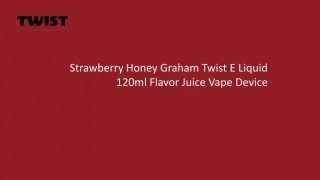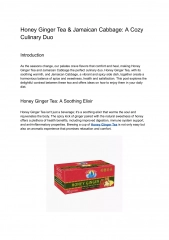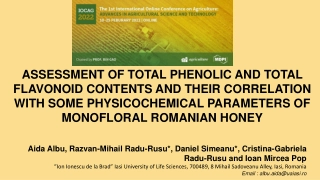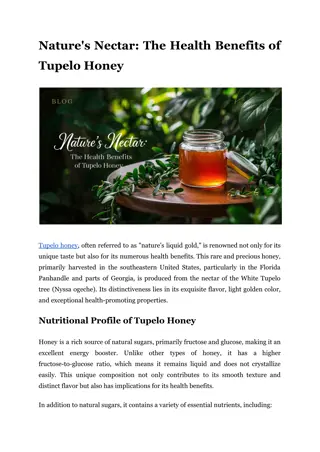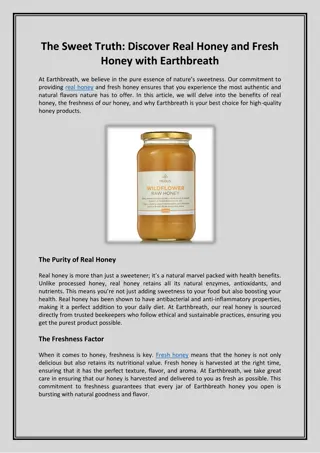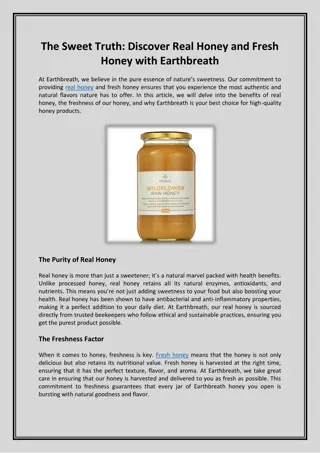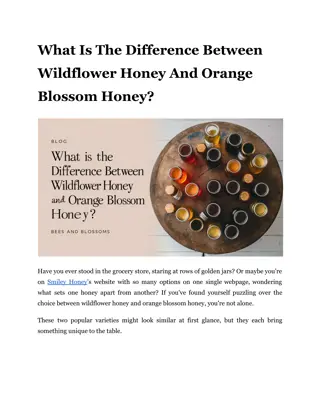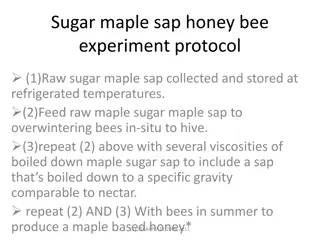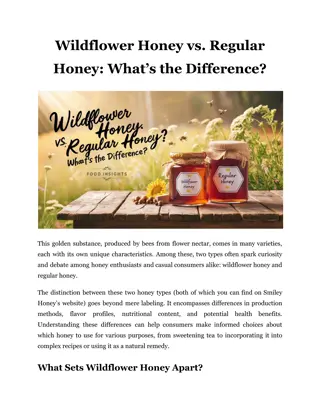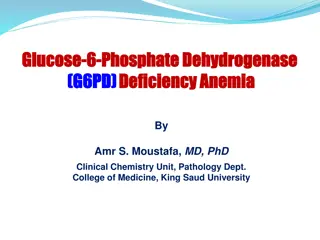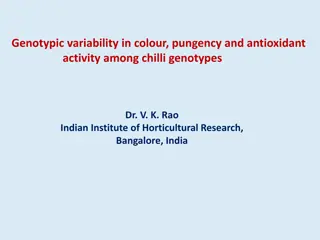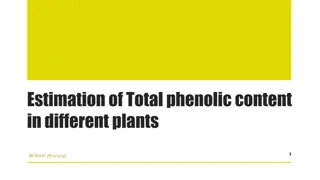The Antioxidant Properties of Honey Explored by Prof. Dr. Eitedal M. Daoud
Explore the fascinating world of honey and its multitude of benefits, from its antioxidant properties to its rich mineral content. Delve into the traditional knowledge of honey alongside modern scientific advancements in apitherapy. Discover how honey, a natural product derived from insects, has been used for centuries for both nutrition and healing purposes. Uncover the various compounds found in honey, including carbohydrates, organic acids, proteins, minerals, vitamins, and polyphenols. Learn about the role of reactive oxygen species (ROS) in cellular signaling and homeostasis.
Download Presentation

Please find below an Image/Link to download the presentation.
The content on the website is provided AS IS for your information and personal use only. It may not be sold, licensed, or shared on other websites without obtaining consent from the author.If you encounter any issues during the download, it is possible that the publisher has removed the file from their server.
You are allowed to download the files provided on this website for personal or commercial use, subject to the condition that they are used lawfully. All files are the property of their respective owners.
The content on the website is provided AS IS for your information and personal use only. It may not be sold, licensed, or shared on other websites without obtaining consent from the author.
E N D
Presentation Transcript
By THE N AME OF ALLH
ANTIOXIDANT PROPARTY OF HONEY BY Prof.Dr EITEDAL M. Daoud Prof. Of Childhealth &Consultant of Clinical Nutrition ,National Research Centre ,Egypt
Honey is an aqueous solution of sugars containing a few secondary metabolites.
It is the only insect-derived natural product with therapeutic, traditional, spiritual, nutritional, cosmetic, and industrial value. In addition to having excellent nutritional value, honey is a good source of physiologically active natural compounds,
HONEY Honey has been used by humanity for thousands of years for nutrition and curative purposes. The traditional knowledge of honey and traditional knowledge of honey and modern science are merged in modern science are merged in apitherapy apitherapy, , which denotes the which denotes the medical use of honey and bee medical use of honey and bee products. products. The
Carbohydrates are the main componantes of honey and contribute 95 to 97% of its dry weight. In addition to carbohydrates, honey contains numerous compounds, such as organic acids, proteins, amino acids, minerals, and vitamins .Pure honeys were also reported to contain polyphenols, alkaloids,, cardiac glycosides, flavonoids, reducing compounds, and volatile compounds
Honey also contains a lot of minerals such as calcium, copper, iron, magnesium, manganese, zinc phosphorus and potassium
Reactive oxygen species (ROS) are chemically reactive molecules containing oxygen. Examples include peroxides. superoxide, hydroxyl radical, and singlet oxygen. ROS are formed as a natural by product of the normal metabolism of oxygen and have important roles in cell signaling and homeostasis.
Oxidative stress Oxidative stress reflects an imbalance between the systemic manifestation of reactive oxygen species and a biological system's ability to readily detoxify the reactive intermediates or to repair the resulting damage.
Honey is recognized as having different Honey is recognized as having different biological properties, biological properties, including antioxidant effects effects or pharmacological activities ranging from anti-inflammatory, antioxidant, antibacterial, antihypertensive to hypoglycemic effects including antioxidant
Mechanism of action Mechanism of action:
Honey inhibit the formation of free radicals, a Honey inhibit the formation of free radicals, a potential to exert antioxidant activity. potential to exert antioxidant activity. Superoxide formed during inflammation is un Superoxide formed during inflammation is un- - reactive, this is then converted to hydrogen reactive, this is then converted to hydrogen peroxide a much less reactive peroxide radical peroxide a much less reactive peroxide radical generated . generated .
Formation of the oxidant peroxide radical is then catalysed by metal ions (e.g.; iron and copper). Sequestration of these metal ions in complexes with organic molecules is an important antioxidant defense system . Flavonoids and other polyphenols, common constituents of honey, will do this.
Reactive Oxygen Species (ROS) is a phrase used to describe a number of reactive molecules and free radicals radicals derived from molecular oxygen. Glutathione Glutathione (GSH GSH) is an important cellular antioxidant antioxidant that limits cell damage by ROS free
The role of free radicals such as superoxide radicals, hydroxyl radicals and others have been implicated in a number of diseases including cancer, cardiovascular diseases, cataracts, macular degeneration, impaired wound healing, gastrointestinal inflammatory diseases and many other inflammatory processes.
Antioxidant activity, or simply antioxidant capacity of honey is its ability and potential of it to reduce oxidative reactions within the food systems and human health
The Anti The Anti - - Oxidant system Oxidant system Natural honey contains many flavonoids ,phenolic acids ,ascorbic acid, tocopherols, catalase, superoxide dismutase, reduced glutathione, and peptides, most of which work together to provide a synergistic antioxidant effect .
The anti The anti- -oxidant content of Honey is measured oxidant content of Honey is measured by: by: its capacity to scavenge its capacity to scavenge free radicals, and its capacity to its capacity to inhibit the generation of inhibit the generation of superoxide radicals. superoxide radicals. Or due to the combined activity of these minor components through synergistic effects . free radicals, and
It is noticed that the botanical origin of honey has the greatest influence on its anti- oxidant activity, while processing, handling and storage affects its anti-oxidant capacity only to a minor degree
So , So ,the antioxidant capacities, the antioxidant capacities, of honey of honey is useful for the prevention of chronic is useful for the prevention of chronic inflammatory process like : inflammatory process like : atherosclerosis, atherosclerosis, diabetes mellitus , diabetes mellitus , cardiovascular diseases cardiovascular diseases ,some immunological diseases and cancer.
This ability of honey to neutralize free This ability of honey to neutralize free radicals has been demonstrated . radicals has been demonstrated . Via a clinical trial of honey dressing on burns has clinical trial of honey dressing on burns has been indicated that the way in which honey been indicated that the way in which honey initiates healing in burns is the control of initiates healing in burns is the control of free radicals by the antioxidant activity of free radicals by the antioxidant activity of honey ( honey (Subrahmanyam Subrahmanyam, , 2003 Via a 2003). ).
In humans, In humans, after honey is consumed, after honey is consumed, an increase in plasma antioxidants has been increase in plasma antioxidants has been reported, reported, and the antioxidants give protection and the antioxidants give protection in the blood stream and within cells ( in the blood stream and within cells (Schramm et al., et al., 2003 2003), ), demonstrating that the demonstrating that the bioavailability and bioactivity of honey gives a bioavailability and bioactivity of honey gives a high efficiency antioxidant transfer from honey high efficiency antioxidant transfer from honey to plasma to plasma an Schramm
The occurrences of human diseases, which are linked to oxidative stress, have led to the application of antioxidants to treat diseases. Small molecule dietary antioxidants such as vitamin C, vitamin E and carotenoids have generated particular interest as defenses against degenerative diseases. However, some studies have indicated that organic compounds such as flavonoids and phenolics are considerably more potent antioxidants. The use of honey in the treatment of chronic wounds, diabetic ulcers, cataracts and other eye ailments, peptic ulcers and gastric ailments have been well documented.
honeys had revealed that in addition to C and E vitamins and catalase, the honeys also contain flavonoid and phenolic compounds. The antioxidant activities of these organic compounds were determined in terms of their anti radical power (ARP) as assessed by DPPH radical scavenging assay and their total antioxidant power (TAP), as measured by FRAP assay. A high correlation between the honey phenolics and the hydrogen peroxide level in honey is another new finding. It indicates that honey phenolics play a role in determining hydrogen peroxide level in honey


